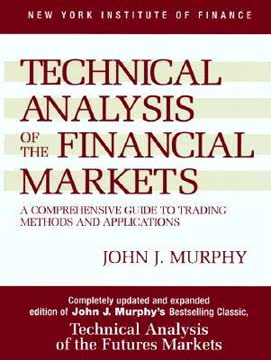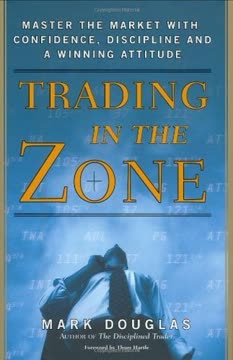Key Takeaways
1. Master Your Psychology: The Foundation of Trading Success
"You create your own results, and your results right now come from playing a game with no training."
Self-awareness is crucial. Successful trading begins with understanding yourself, your beliefs, and your emotional responses to market fluctuations. Traders must develop a strong psychological foundation to maintain discipline and make rational decisions under pressure.
Commitment is key. Treat trading as a serious profession, not a hobby. This involves dedicating time and effort to education, self-improvement, and developing a structured approach to the markets. Successful traders often spend as much time working on themselves as they do analyzing markets.
Overcome limiting beliefs. Identify and challenge beliefs that may be holding you back, such as the need to always be right or the fear of missing out. Replace these with more empowering beliefs that support your trading goals and strategy.
2. Develop a Comprehensive Business Plan for Trading
"Trading is really a business. Most businesses fail because of lack of planning. Treat trading like a business, not a hobby."
Define your mission and objectives. A well-crafted business plan should clearly state your trading goals, risk tolerance, and overall mission. This provides a framework for decision-making and helps maintain focus during challenging market conditions.
Outline your strategies and procedures. Detail your trading systems, risk management rules, and daily routines. This includes:
- Market analysis methods
- Entry and exit criteria
- Position sizing strategies
- Record-keeping procedures
- Ongoing education plans
Plan for contingencies. Anticipate potential challenges and develop strategies to address them. This might include dealing with technology failures, unexpected market events, or personal emergencies that could impact your trading.
3. Design Trading Systems Tailored to Market Types
"The common mistake most people make in designing systems is to try to find a system that works in all market conditions. That's insane."
Identify market types. Recognize that markets can be categorized into different types, such as trending, ranging, or volatile. Each market type presents unique opportunities and challenges for traders.
Develop specialized systems. Create trading strategies that are optimized for specific market conditions. This might include:
- Trend-following systems for strong directional markets
- Mean-reversion strategies for range-bound markets
- Volatility-based approaches for turbulent conditions
Adapt to changing conditions. Regularly assess the current market type and be prepared to switch between different trading systems as conditions evolve. This flexibility can help maintain consistent performance across various market environments.
4. Understand and Implement Effective Position Sizing
"Position sizing tells you 'how much' throughout the course of a trade. It is probably responsible for 90% of your performance variability; that's how important it is."
Recognize the impact. Position sizing is often overlooked but plays a crucial role in determining overall trading performance. It affects both potential returns and risk management.
Align with objectives. Develop position sizing strategies that support your specific trading goals. This might involve:
- Conservative approaches for capital preservation
- Aggressive sizing for maximum growth
- Adaptive methods that adjust based on recent performance
Use simulations. Employ Monte Carlo simulations and other analytical tools to test different position sizing models. This can help identify optimal strategies for your trading system and risk tolerance.
5. Keep Trading Simple and Avoid Prediction
"Success comes from following simple steps. When you understand that and practice it, your performance will improve dramatically."
Simplify your approach. Complex trading systems are often less robust and more prone to failure. Focus on developing straightforward strategies that are easy to understand and execute consistently.
Embrace uncertainty. Recognize that accurate market prediction is nearly impossible. Instead of trying to forecast market moves, concentrate on managing risk and responding to actual market behavior.
Follow your system. Develop confidence in your trading plan and resist the urge to deviate based on hunches or short-term market noise. Consistency in execution is often more important than complexity in strategy.
6. Focus on Exits and Risk Management
"Exits are the key to making money."
Prioritize exit strategies. While many traders obsess over finding the perfect entry, it's often the exit that determines profitability. Develop clear rules for both stop-losses and profit-taking.
Manage risk first. Always know your potential loss before entering a trade. Use stop-loss orders or mental stops to limit downside risk, and consider using trailing stops to protect profits as trades move in your favor.
Let winners run. Avoid the common mistake of taking profits too quickly. Develop strategies that allow you to capture larger moves while still protecting gains, such as:
- Trailing stops
- Partial profit-taking
- Time-based exits for trend trades
7. Continuously Improve and Learn from Mistakes
"You cannot ignore the fundamentals."
Track your performance. Keep detailed records of all trades, including both wins and losses. Analyze this data regularly to identify patterns, strengths, and areas for improvement.
Embrace mistakes as learning opportunities. Rather than becoming discouraged by losses, view them as valuable feedback. Conduct post-trade analysis to understand what went wrong and how to avoid similar mistakes in the future.
Invest in ongoing education. The markets are constantly evolving, and successful traders never stop learning. Stay updated on new strategies, tools, and market dynamics through:
- Books and research papers
- Trading seminars and workshops
- Mentorship from experienced traders
- Practice in simulated trading environments
Last updated:
FAQ
What's Super Trader about?
- Focus on Trading Success: Super Trader by Van K. Tharp is a guide to achieving consistent profits in various market conditions, emphasizing personal psychology, business planning, and systematic trading.
- Five-Step Approach: The book outlines a five-step process for traders, including personal development, business planning, strategy creation, position sizing, and mistake minimization.
- Mindset and Self-Improvement: It stresses that successful trading is as much about mindset and self-awareness as technical skills and market knowledge.
Why should I read Super Trader?
- Transformative Insights: The book offers insights into the psychological aspects of trading, often overlooked by traders, with practical exercises to improve mental state and discipline.
- Structured Learning: It provides a structured approach for developing a personalized trading plan, applicable to both novice and experienced traders.
- Long-Term Success: By focusing on self-improvement and a solid business plan, readers can achieve long-term success rather than short-term gains.
What are the key takeaways of Super Trader?
- Self-Work is Essential: Working on oneself is critical for successful trading, with an emphasis on identifying and overcoming limiting beliefs.
- Develop a Business Plan: A well-defined business plan guides trading decisions and strategies, including mission statements, goals, and tactical strategies.
- Position Sizing Matters: Effective position sizing is vital for managing risk and achieving trading objectives, with the CPR model introduced for alignment with goals.
What is the five-step approach outlined in Super Trader?
- Work on Yourself: Address personal issues affecting trading performance, including self-appraisal and identifying limiting beliefs.
- Develop a Business Plan: Create a comprehensive plan outlining trading goals, strategies, and risk management techniques.
- Create Effective Strategies: Develop strategies that align with market conditions and personal objectives, adapting to different market types.
- Understand Position Sizing: Emphasize position sizing for managing risk and achieving goals, with models to determine appropriate sizes.
- Minimize Mistakes: Monitor performance and minimize mistakes through discipline and adherence to trading rules.
How does Super Trader address the psychological aspects of trading?
- Beliefs Shape Reality: Traders must examine their beliefs about themselves and the market, as these influence behavior and outcomes.
- Self-Responsibility: Encourages taking full responsibility for results, promoting learning from mistakes rather than blaming external factors.
- Mindfulness Practices: Introduces mindfulness techniques to help traders stay present and focused, reducing emotional reactions.
What is the importance of a mission statement in trading according to Super Trader?
- Guides Decision-Making: A mission statement serves as a guiding principle, helping evaluate opportunities against core objectives.
- Clarifies Goals: It clarifies goals and motivations, ensuring actions align with long-term vision for success.
- Enhances Focus: A clear mission helps maintain focus and avoid distractions that do not contribute to the overall strategy.
What is the CPR model for position sizing mentioned in Super Trader?
- Risk Management Framework: The CPR model stands for Capital, Position, and Risk, providing a structured approach to risk on each trade.
- Aligns with Objectives: Helps align position sizes with trading objectives, managing risk effectively while pursuing profits.
- Dynamic Adjustments: Allows for dynamic adjustments based on market conditions and performance, promoting flexibility.
What is the Belief Examination Paradigm in Super Trader?
- Assess Your Beliefs: A tool to identify and evaluate beliefs about trading, considering their origins and influence on behavior.
- Identify Limitations: Uncovers limiting beliefs that may hinder performance, prompting questions about their usefulness.
- Transform Limiting Beliefs: Aims to transform limiting beliefs into empowering ones, essential for a mindset conducive to success.
What are some common mistakes traders make according to Super Trader?
- Ignoring Trading Rules: Not following established rules can lead to emotional decision-making and losses.
- Risking Too Much: Failing to manage risk by risking too much capital on a single trade can lead to significant drawdowns.
- Emotional Exits: Exiting trades based on emotions rather than criteria can minimize profits and maximize losses.
How can I apply the concepts from Super Trader to improve my trading?
- Self-Assessment: Conduct an honest self-appraisal to identify personal beliefs and psychological barriers affecting trading.
- Create a Business Plan: Develop a comprehensive plan outlining goals, strategies, and risk management, aligning with your mission.
- Practice Mindfulness: Incorporate mindfulness practices to enhance focus and reduce emotional reactions for rational decision-making.
What are some effective daily procedures suggested in Super Trader?
- Daily Mental Rehearsal: Start each day with a mental rehearsal to anticipate challenges and plan responses.
- Debriefing: Conduct a debriefing session at the end of each day to assess performance and identify mistakes.
- Tracking R-Multiples: Keep track of R-multiples to evaluate performance over time, allowing for informed strategy adjustments.
What are the best quotes from Super Trader and what do they mean?
- "You create your own results.": Emphasizes personal responsibility in trading, suggesting ownership of decisions and outcomes.
- "You cannot trade the market; you can only trade your beliefs about the market.": Highlights the psychological aspect, emphasizing mindset and beliefs' influence on success.
- "Enjoy your obstacles.": Encourages embracing challenges as growth opportunities, leading to better decision-making and resilience.
Review Summary
Super Trader is highly regarded by readers for its focus on trading psychology, position sizing, and developing a personalized trading system. Many consider it essential reading for traders at all levels. The book emphasizes self-awareness, treating trading as a business, and managing risk effectively. Readers appreciate Tharp's no-nonsense approach and practical advice. Some find the position sizing chapter confusing, but overall, the book is praised for its comprehensive coverage of trading psychology and risk management. Many readers report significant improvements in their trading after applying Tharp's principles.
Similar Books










Download PDF
Download EPUB
.epub digital book format is ideal for reading ebooks on phones, tablets, and e-readers.






